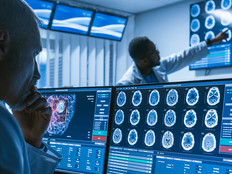5 Steps Healthcare CIOs Can Take to Get Ready for Blockchain
Blockchain could be the conduit to a more secure, transparent and interoperable future for healthcare, says Don Tapscott, co-founder of the Blockchain Research Institute. Tapscott, who spoke at the College of Healthcare Information Management Executives (CHIME) 2017 Fall CIO Forum on Nov. 3 in San Antonio, Texas, argued that as pushes for advancements in health IT bump up against the barriers of cost and legacy systems, blockchain can help rebuild the health system from the ground up.
“Tinkering is not going to be sufficient, we need to actually reinvent healthcare. Fortunately, there’s a new technology in healthcare emerging that can help us do that,” said Tapscott, speaking about blockchain, the ledger technology that underlies bitcoin.
Some organizations are already beginning to explore the use of blockchain in healthcare and how it can improve provider interoperability, data sharing and quality measurement while expediting and improving the claims process. Delaware and Illinois, for example, have both launched pilots this year to explore how the tech can improve medical processes, including medical licensing and Medicaid preauthorization.
Providers, however, are still relatively uncertain as to how to begin to approach the technology. To this end, Tapscott offers five tips on how the health IT community can get started with blockchain in a collaborative way.
SIGN UP: Get more news from the HealthTech newsletter in your inbox every two weeks
1. Get to Know Blockchain on Your Own Time
To start, CIOs and other healthcare IT leaders can pull blockchain technology into their own lives by tapping some of the technologies already on the market that relate to bitcoin.
“Personal use is a precondition for any kind of comprehension,” said Tapscott.
He suggests visiting blockchain.info to get a grip on the blockchain bitcoin exchange and value or obtaining a mobile wallet and purchasing something small using bitcoin.
“This is going to take you three minutes and it will teach you more about blockchain than if I talked to you all day long,” said Tapscott.
2. Tap Blockchain Resources for Some Baseline Education
At this point in time, there is no lack of information on blockchain available to the average person.
Tapscott suggests tracking down some resources (you can find his own TED Talk here) such as those from the Blockchain Research Institute or info on how companies such as Microsoft are incorporating blockchain into their existing technologies. He also suggests setting up something as simple as a Google Alert for blockchain in healthcare to see how use cases are evolving every day.
“Every day you’ll be staggered,” Tapscott said.
3. Sift Out Bitcoin-Curious Talent
It’s very likely that within an organization’s health IT team, there’s already a person who is genuinely interested in blockchain.
“Somebody has been on the side buying bitcoin for the last six years … . Chances are they already have some expertise,” said Tapscott, suggesting that organizations harness this knowledge and apply it to their own blockchain projects.
4. Launch a Blockchain Pilot
Once a CIO is familiar and comfortable with the technology at hand, Tapscott says it’s time to tap a company already working with blockchain in order to try it out on a smaller scale by launching a blockchain pilot.
“A good place to start is around a patient [electronic health] record,” said Tapscott. “And if you can, build partnerships with other [healthcare organizations] so that you share the costs and get synergy.”
5. Begin Thinking About IT Architecture
With legacy architectures already in place, implementing the changes necessary to enable blockchain at its fullest extent is certainly going to be difficult, said Tapscott.
“How do you create the conditions where, for an enterprise, new investments contribute to a desired future as opposed to making it worse, building up your legacy?” asked Tapscott. And while he admits that there are not answers around this issue yet, it’s important to begin having discussions around integrating blockchain into the existing architecture.
“Get your architecture group starting to think about the enterprise as a whole,” he said.
He says that CIOs should keep in mind that using blockchain is about taking an opportunity to turn the healthcare delivery system and existing IT infrastructure on its head.
“It’s about trying to create an awakening,” Tapscott said, encouraging health IT leaders to begin sharing knowledge and experiences with their peers as they dip their toes into blockchain pilots. “This is the technology that’s going to take healthcare forward for the next decade or two along with AI and machine learning … . Start things happening, start getting people turned on [to the technology] and maybe we can do this.”









